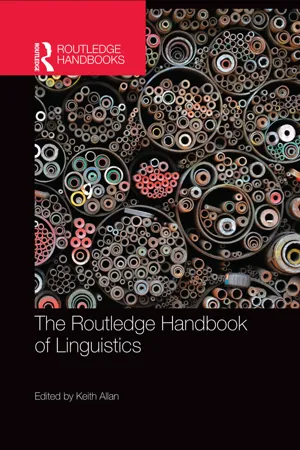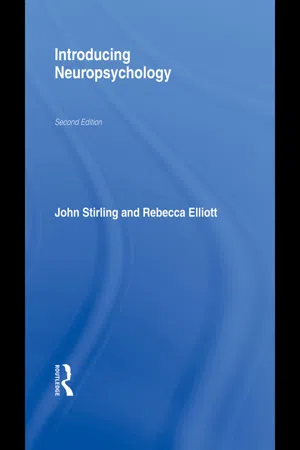Psychology
Language and the Brain
"Language and the Brain" explores the intricate relationship between language processing and the brain. It delves into how the brain comprehends, produces, and acquires language, as well as the neural mechanisms underlying these processes. This field of study encompasses various aspects of cognitive neuroscience, including language development, language disorders, and the impact of brain injuries on language abilities.
Written by Perlego with AI-assistance
Related key terms
6 Key excerpts on "Language and the Brain"
- eBook - ePub
- Keith Allan(Author)
- 2015(Publication Date)
- Routledge(Publisher)
Neurolinguistics Mind, brain, and language David Kemmerer19.1 Introduction
The goal of neurolinguistics is to understand how the cognitive capacity for language is subserved by the biological tissue of the brain. This interdisciplinary field of research began in the mid-nineteenth century, and by the early twentieth century several basic aspects of the neural architecture of language had already been discovered, such as left-hemisphere dominance and the strong reliance of speech perception and production on certain regions in the temporal and frontal lobes. These initial insights came primarily from investigations of brain-damaged patients who displayed fairly consistent correlations between, on the one hand, particular patterns of impaired and preserved linguistic abilities, and on the other hand, particular patterns of lesioned and intact brain structures. But even though that first wave of neuropsychological exploration was of great historical importance, the value of the studies was limited by their lack of precision on both sides of the language–brain relationship. From the mid-twentieth century up to the present, however, the whole field evolved quite dramatically for a variety of reasons, including the maturation of modern linguistics, the cognitive revolution in psychology, the emergence of computer science and artificial intelligence, and the invention and progressive refinement of numerous brain mapping methods. Due to these developments, neurolinguistics is now a vibrant, rapidly growing field in which researchers with different backgrounds frequently collaborate to conduct empirical and theoretical studies on diverse topics.The following synopsis begins by summarizing several kinds of cortical organization as well as the most commonly used brain mapping methods. It then provides a selective review of recent hypotheses and findings about the neural representation and processing of spoken word forms, printed word forms, word meanings and sentences. Although some of the most well-supported contemporary perspectives are covered, space limitations only allow a small amount of material to be included, far less than is actually available in the relevant literature. Further information can be found in the references listed under ‘Further reading.’ - eBook - ePub
Introducing Neuropsychology
2nd Edition
- John Stirling, Rebecca Elliott(Authors)
- 2010(Publication Date)
- Psychology Press(Publisher)
CHAPTER 6 Language and the BrainCONTENTS
Introduction 129The classic neurological approach and aphasia 130Connectionist models of language 134The psycholinguistic approach 138The modern era of language research 139Language and laterality 149Chapter summary 150INTRODUCTION
Think for a moment of the complex range of computational skills that are involved in understanding and generating language. Yet by the age of 4 or 5 most children can understand language (in their “mother” tongue at least) spoken at a rate of several words per second. This stream of sounds is continuous—not conveniently broken up like words on a page—and the listener has to know the boundaries between words in order to make sense from them. By late adolescence most humans will have a working understanding of many thousands of words (up to 50,000 for English speakers). Humans start to produce language as soon as they begin to acquire their vocabulary. In fact, some psychologists argue that using language precedes knowledge of words, and they cite the verbal-babble interactions of mother and child as examples of pre-vocabulary “speech”.By about 2 to 3 years old, children can effortlessly generate completely novel utterances according to implicit grammatical rules, and conduct meaningful conversations both with other children and with adults. Language development also seems to occur in the most adverse circumstances: consider, for example, the acquisition of complex language in deaf children. Indeed, of all psychological attributes, language is surely the one that sets humans apart. Other animals may use gestures and sounds to communicate, but the complexity and sophistication of human language suggests that extensive regions of the brain must be dedicated to dealing with it.Scientific interest in language dates back to the earliest attempts by researchers to study the brain in a systematic way, with the work of Dax, Broca, and Wernicke in the 19th century. Since then, interest in all aspects of language has intensified to the point where its psychological study (psycholinguistics) is now recognised as a discipline in its own right. The development of research tools such as the Wada test and, more recently, structural and functional imaging procedures has enabled researchers to examine language function in the brains of normal individuals (see Chapter 2 - Victor M. Rentel, Samuel A. Corson, Bruce R. Dunn(Authors)
- 2017(Publication Date)
- Routledge(Publisher)
Chapter 1Linguistic and Psycholinguistic Perspectives on Brain Mechanisms and Language
by Jerry ZutellINTRODUCTION
During the past decade various developments in neurological research have greatly increased our understanding of how the brain and central nervous system (CNS) mechanisms organize and control human behavior. Given science’s abiding interest in language as one of man’s most unique and complex activities, it is not surprising that much of this work has been directed toward understanding the neurological mechanisms underlying language learning and use. And, in fact, recent brain research has greatly contributed to our understanding of the neurological correlates of linguistic activity. (See bibliography and other papers in this volume.)However, such investigations provide usable information about language only to the degree that they conform to an acceptable linguistic research paradigm, as well as to a biological one. Yet, at present there is no single universally received research paradigm for the study of language comparable to those established for the physical sciences (Kuhn 1970). In fact, the direction of linguistic, psycholinguistic and socio-linguistic research has changed markedly over the last decade and continues to change even now. There is, for example, much debate about 1) what constitutes a realistic yet analyzable segment of language, 2) which proposed linguistic units and dimensions have psychological reality, and 3) what analytic techniques provide fruitful insights into language structure, use and acquisition. Until such major issues are resolved, it will be difficult to determine what neurological investigations using rather traditional definitions of language tell us about neurolinguistic processes.On the other hand, it would be absurd to halt neurolinguistic investigations until a broader and more universally accepted language research paradigm has been established. The current state of research and research paradigms available in the various language disciplines, however, suggests that a review of current neurolinguistic findings in the context of related developments in linguistic theory and psycholinguistic research may yield both new and more refined interpretations of the literature in neurolinguistics; thus the goal and topic of the present chapter.- eBook - ePub
- Dani Byrd, Toben H. Mintz(Authors)
- 2011(Publication Date)
- Wiley-Blackwell(Publisher)
Others think that the insights we can glean from understanding how the brain implements language could be useful in designing machines that can communicate with spoken language. Another major reason to study brain function is to be able to intervene when language is impaired for some neurological reason. Understanding how affected brain regions play a role in language could, if not help provide a cure for the impairment, at least inform us how best to manage it to improve a patient’s ability to communicate. Finally, we are now at a point in time in the advancement of neuroimaging techniques, as well as in the sophistication of our linguistic and psycholinguistic (functional) theories, that studying the organization of language in the brain can actually influence those theories; we might change or deepen our functional models based on what we find by “looking inside” the brain. The Locations of Language in the Brain An early guiding interest in neurolinguistic research was understanding whether various linguistic functions are located in distinct areas in the brain, and if so, where. Where are words stored? Where are phonological segments processed? Where are morphological processes carried out? The term used to describe the scenario where certain kinds of representations and processes are located in specific areas is modular organization. Of course, there was always the understanding that the organization of language in the brain might not be entirely modular, and that some representations and processes might be distributed – where a given function is processed by multiple different regions in the brain. After all, it’s been recognized for over 100 years that the brain is highly interconnected, so there is much reason to believe that many regions could be involved with a given function. Never-theless, there has been a strong tendency to seek out physical areas of the brain that correspond to functional components of theories of language representation and processing - eBook - ePub
The Future of the Brain
Essays by the World's Leading Neuroscientists
- Gary Marcus, Jeremy Freeman(Authors)
- 2014(Publication Date)
- Princeton University Press(Publisher)
LANGUAGELanguage is uniquely human, at least in the sense of our being able to talk not just about the here and now but about the abstract, the complex, the future, and the hypothetical. Language is also uniquely difficult to study; there are no direct animal models (though birdsong can be informative), and sharp ethical limits constrain what techniques can be used. If most work in neuroscience is on vision and motor control, it’s partly because those areas of the mind are more easy to study.David Poeppel argues that the key challenge in understanding language is to bridge between a vocabulary of neural elements (such as axons and cell bodies) and a vocabulary of linguistic elements (such as nouns and verbs). He suggests that techniques such as brain imaging have not been adequate to the task but give hints into research that might take us closer. Simon Fisher explores an analogous set of challenges in bridging between DNA, genes, brains, and complex behavior, focusing on the case of human language. As he puts it, “we are at a watershed in genomics research, one that is set to transform multiple fields of neuroscience in unprecedented ways.”THE NEUROBIOLOGY OF LANGUAGE David Poeppel The Origin and Transformation of Research on the Neurobiology of LanguageThe ease, speed, and apparent automaticity with which we can greet a friend, follow a conversation, or read this sentence belie the considerable complexity of such seemingly effortless language tasks. Even the most elementary linguistic “event,” say recognizing a single spoken word (“prose”), requires the coordination of a number of complex subprocesses (for example, analysis of the basic acoustic signal attributes, phonetic decoding, look-up/matching of the item in one’s mental dictionary, retrieval of the word’s pronunciation instructions, meaning, and grammatical specifications). And comprehending or producing a sentence (“Composing prose is an arduous affair”) entails the subtle orchestration of dozens of underlying component operations. - eBook - ePub
- Geoffrey Beattie, Andrew Ellis(Authors)
- 2014(Publication Date)
- Psychology Press(Publisher)
14The cognitive neuropsychology of language and communicationIn the book so far we have tried to draw various conclusions about the nature of human communication and language. To support our claims we have made reference to observations and data. Sometimes these were simple assertions about the way language works or the way people communicate; sometimes the observations arose out of more carefully controlled studies or experiments. Recently an increasing number of psychologists are being attracted by another source of pertinent observations and constraints on how we conceptualize communication and language. This other source is the effects of brain injury on the communicative and linguistic abilities of previously normal people.The first and perhaps most important point to note is that brain injury (such as a stroke or missile wound) can disrupt communicative and linguistic skills in a great many different ways. Following a stroke one rarely loses all language abilities and perhaps never loses all capacity for communication. Usually a subset of language skills is impaired. One patient may, for example, develop severe word-finding problems and have difficulty putting words to concepts, while a second can still produce single words but can no longer string them together to form grammatical sentences. A third patient may have problems specific to understanding speech and complain that everything sounds like a foreign language, while a fourth may have a discrete and not too disabling problem in ‘sounding out’ new and unfamiliar written words.Whereas language and other disorders have traditionally been studied for what they can teach us about the way the brain works, they are now also being studied for what they can teach us about how communication and language work. If, for instance, a patient has a word finding problem for speech but not writing, then this constrains our models and theories of how normal
Learn about this page
Index pages curate the most relevant extracts from our library of academic textbooks. They’ve been created using an in-house natural language model (NLM), each adding context and meaning to key research topics.





